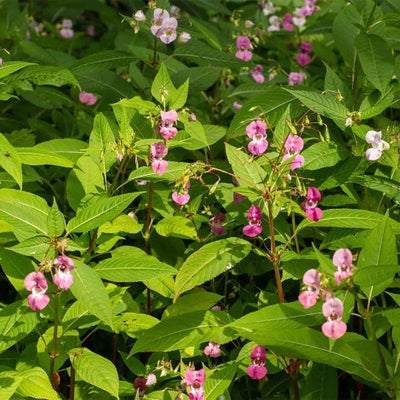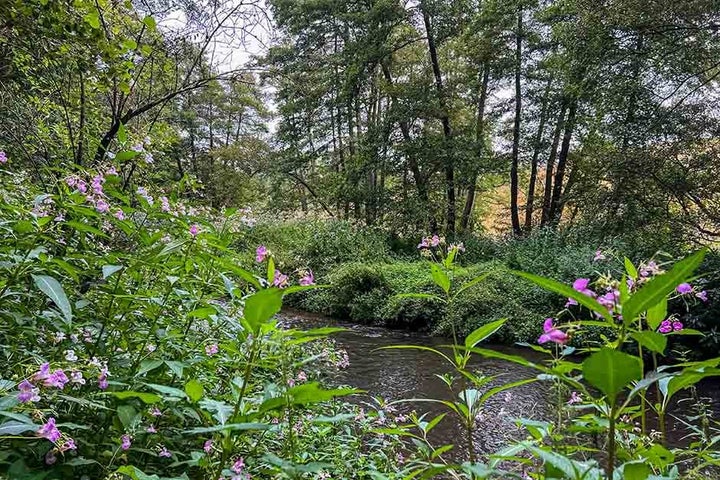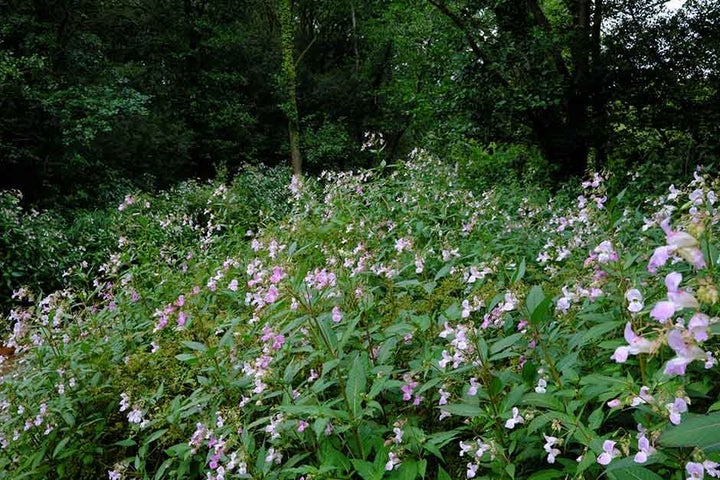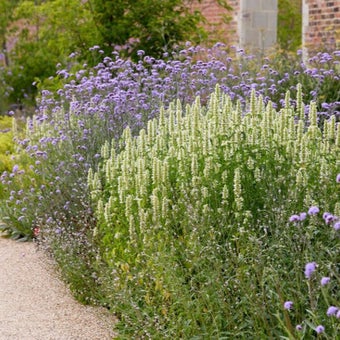
Quick facts
Himalayan balsam’s botanical name is Impatiens glandulifera
Its other common names include Indian balsam, policeman’s helmet, ornamental jewelweed and touch-me-not
It is a tall-growing annual and spreads by seed
Himalayan balsam is an invasive non-native plant listed on Schedule 9 of the Wildlife and Countryside Act 1981 and is a Species of Special Concern
It is illegal to cause Himalayan balsam to spread, and there are restrictions on growing, cultivating, selling and transporting it
Himalayan balsam can be controlled with non-chemical methods
What does Himalayan balsam look like?
Himalayan balsam is a fast growing, tall, upright annual. Seed germinates in early spring, producing broad, almost square seed leaves that are followed by lance-shaped true leaves with finely serrated edges. Sturdy hollow stems, often with reddish tints, grow to a height of about 2m (6½ft) during summer. Scented flowers in shades of pink and purple, and occasionally white, are borne from June to November.
Flowers are followed by elongated seed pods containing up to 16 rounded seeds approximately 3mm (⅒in) wide. Its seed is initially pale and becomes dark brown when ripe. Its root system is surprisingly small, considering the height of the top growth, with roots rarely growing deeper than 15cm (6in). The whole plant dies in autumn or early winter leaving sections of dead, straw-coloured stems lying on the ground.

Is Himalayan balsam a weed?
Himalayan balsam is classed as a non-native invasive plant. It appears on the Wildlife and Countryside Act 1981, Schedule 9 list and the Non- Species Secretariat (NNSS) list of Species of Special Concern, meaning there are restrictions on growing, cultivating, selling and transporting it. If Himalayan balsam is already growing in your garden, this is not considered an offence, though it is recommended that you control or remove it. However, you must not intentionally introduce it or cause it to spread.
The nectar-rich flowers of Himalayan balsam, that bloom well into autumn, make it a favourite of bees and beekeepers, but this is not enough to outweigh its negative impacts, which include:
- Outcompeting native plants for space, light, moisture and nutrients. Rapid growth early in the season leads to dense, tall stands of Himalayan balsam that crowd out other plants and reduce species diversity.
- Soil erosion along water courses. Himalayan balsam often colonises the banks of rivers, streams and ditches. Its shallow roots and annual growth habit do little to stabilise the soil along banks, leading to habitat alteration and degradation.

Frequently asked questions about controlling Himalayan balsam
Here are our answers to your most common questions about dealing with Himalayan balsam:
How invasive is Himalayan balsam?
Since its introduction in 1839, Himalayan balsam has become widespread and common in the UK, primarily along riverbanks, streamsides and other damp areas. Its rapid spread is partly due to its effectiveness at producing and dispersing seed. A single plant can produce hundreds of seeds, and its explosive, easily triggered seed pods propel seed up to 7m (23 ft) from the parent plant. Seed can travel much further and colonise new areas by floating down water courses, and can remain viable for two years.
Humans are Himalayan balsam’s other main means of distribution. This might be through deliberate sharing and spreading of seed by gardeners who appreciate its ornamental qualities but are unaware of its invasiveness, or inadvertently by moving soil that contains seed.

Do I need to get rid of Himalayan balsam?
If Himalayan balsam is already growing in your garden, or on your land, and you are not intentionally keeping or cultivating it, or causing it to spread, then you are not committing an offence. However, because it is a non- species a relevant environmental authority can order control measures if they deem it necessary.
Due to Himalayan balsam’s invasiveness and the negative impacts it has on native species and the environment, most gardeners want to get rid of it if it appears.
What is the easiest way to get rid of Himalayan balsam?
To eradicate Himalayan balsam from your garden, it is important to prevent plants from flowering and setting seed. Its seed can remain viable in the soil for two years, so by using the control methods below, you can rid your garden of it within a few years.
- Hoe off and young plants – hoe on a warm, dry or windy day, so exposed roots dry out quickly and die. Check regularly for emerging seedlings, especially along the banks of watercourses where seed may arrive from upstream.
- Cut regularly to prevent seed production – use secateurs, a strimmer, brushcutter or mower, depending on how many plants you need to cut and how easily you can access them. Cut as low as possible, ideally below the first on the stem to reduce regrowth and branching. It may be necessary to cut back plants up to three times during the to ensure they don’t flower. This method limits soil disturbance.
- Hand pull – grasp a lower section of stem and pull out the whole plant along with the root system. This is easiest in spring and early summer when plants are still relatively short. It is still feasible to pull out taller plants during summer, but this should be done before they start flowering.
- Fork out plants – if you find it difficult to remove the roots by hand pulling, use a hand fork on small plants and a border fork on larger plants. Fully insert the tines to the side of the main stem and lift out the roots.
- Smother seedlings – on ground that is level or with only a slight slope, cover the soil in late winter/early spring with a compostable material, such as cardboard, and then a 10-20cm (4-8in) thick layer of organic matter. Alternatively, use a heavy grade matting – this would be suitable for sloping ground. Keep soil covered for a few years, topping up the mulch layer if necessary, so no viable seed remains.
- Hire a specialist weed control contractor – if you are unable to control Himalayan balsam yourself, consider using a reputable company that specialises in the removal of invasive non-native plants. The organisations below have lists of these contractors.
PCA (Property Care Association) Invasive Weed Control GroupInvasive Non-Native Specialists Association
The British Association of Landscape Industries (BALI)
Trustmark Government Endorsed Standards
Replant cleared areas
After you have eradicated Himalayan balsam from the bank of a river, stream or ditch, consider adding a plant with roots that will help to stabilise the soil; for ideas see our pages on steep banks and slopes and bank and ditch habitats. In very damp soil, marginal plants would be suitable. Ideally, opt for those that flower in late summer and autumn to provide pollinators with an alternative source of nectar and pollen.
How should I dispose of Himalayan balsam?
Himalayan balsam (and soil containing its seed) is regarded as 'controlled waste' under the Environmental Protection Act (Duty of Care) Regulations. If possible, destroy plants on site. If removal is necessary, the Environment Agency needs to be informed and you must use a registered waste carrier and an authorised disposal site. Contact the Environment Agency or your local council for information on authorised sites. If you use licensed contractors, ensure they use registered disposal sites and provide copies of waste transfer permits.
The following government websites provide more information:
Treatment and disposal of invasive non-native plants: RPS 178
How to stop invasive non-native plants from spreading
Do not put Himalayan balsam in your home , council or household waste bin.
Should I use weedkiller?
No – although Himalayan balsam is an invasive non-native plant, it can be controlled by using non-chemical methods. It is often found the banks of watercourses, where there are additional legal restrictions on the use of weedkillers.
The RHS does not support the use of weedkillers and recommends that alternative control methods are used. However, when invasive plants are a threat to and gardeners struggle to control them with cultural methods, targeted use of regulated weedkillers may be an option. Garden centres and large retailers selling weedkillers have trained staff who can advise on suitable products for your needs.

















